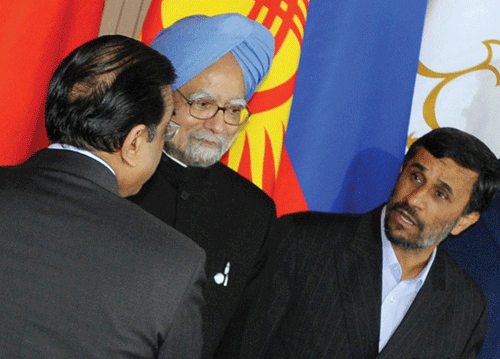As President Barack Obama struggles for direction in Afghanistan, the prospect of reconciliation between the United States-backed government of Hamid Karzai and Taliban members has concentrated minds not just in Pakistan, which backs the idea, but also in Tehran and New Delhi. Iran’s deputy foreign minister, visiting New Delhi in early August said the two countries’ views on Afghanistan were “close.”
India is skeptical over Tehran’s desire to phase out US-led Western troops, but both countries want a stable, strong government in Kabul that can contain the Taliban. Iran and India have been wary of Sunni militants in Afghanistan since the US and its Saudi and Pakistani allies fostered a “holy war” against Soviet secularism in the 1980s. But Iranian ministerial visits to India in July and August focused not just on cooperation over Afghanistan, but on also improving economic links.
Iran and India have complimentary energy interests: India, which hopes for a sustained 8 to 10 percent growth despite meager energy resources, has long eyed Iran’s substantial oil and gas reserves — each the world’s second largest. It already imports around 14 percent of its crude from Iran, worth $11 billion annually. Such signs of trade and partnership go down like a lead balloon in Washington, which is pushing for greater isolation of Iran over its nuclear program. Back in 2006, Washington warned it would end nuclear co-operation with India if New Delhi did not vote in the International Atomic Energy Agency to refer Iran to the United Nations Security Council. Since then, India has reluctantly followed the US lead, despite domestic criticism. Pressure from Washington has intensified under Obama, but so has Indian disquiet.
Anticipating the latest US sanctions targeting gasoline supplies to Iran, the Indian private sector group Reliance Industries ended sales last year. But this summer New Delhi resumed talks with Tehran over the ambitious “peace pipeline.” This project had been bantered about for the past decade, though India had dragged its feet under US pressure, pricing disagreements and worries over the transit route through Pakistan. In March the project morphed into an Iranian-Pakistani pipeline scheduled to pump at least 7.7 billion cubic meters (bcm) of gas each year from 2015 to 2040. Renewed talks to extend the pipeline to India show New Delhi is still hungry for what Iran claims would be 55 bcm of natural gas annually.
In return, Iran wants Indian investment in its vast but undeveloped South Pars gas field, and has targeted the state-owned Oil and Natural Gas Corporation Videsh (OVL) and the privately owned Hinduja group. Short of capital thanks to Western sanctions, Tehran needs some $200 billion to increase gas production from 0.6 bcm per day to 1 bcm by 2014. In August Iran stressed its desire to boost bilateral trade between the two countries from its current $15 billion, emphasizing India’s role in developing Chabahar port in Iran’s Sistan-Baluchestan province, which New Delhi sees as a major trade route that bypasses Pakistan into Afghanistan and central Asia. Iran seeks to raise the port’s annual capacity from two million to 12 million tons.
Chabahar is probably now the litmus test of Indian-Iranian relations, as Tehran may link Indian participation to wider co-operation. New Delhi has already helped finance a highway from Chabahar to Milak, on the Afghan border, where there is a crossing to Zaranj, in Afghanistan, to which India has laid a 213-km road from Dilaram, a major Afghan transport hub.
India is keen to develop the potential of this route. There is even speculation over an undersea gas pipeline to India, bypassing Pakistan, to supply Iranian and Turkmen gas. Fresh Indian investment into Iran may irritate the US, but New Delhi cannot ignore new trade patterns in central Asia that are giving China access to Siberian timber, Mongolian iron ore, Kazakh oil, Turkmen natural gas and Afghan copper through roads, railways, pipelines and the Pakistani deep-sea port of Gwadar.
Gwadar, constructed with Chinese assistance and just 72 kilometers from the Iranian border, gives Beijing an economic edge over India and a military vantage point to monitor the US navy in the Persian Gulf and the Indian navy in the Arabian Sea.
Without access to Iranian and Turkmen gas, India will be short of energy. Hence New Delhi has reiterated its support for diplomacy over Tehran’s nuclear program. How all this squares with tighter US sanctions — much less US or Israeli air-strikes — remains to be seen.
GARETH SMYTH is the former Tehran correspondent for the Financial Times










